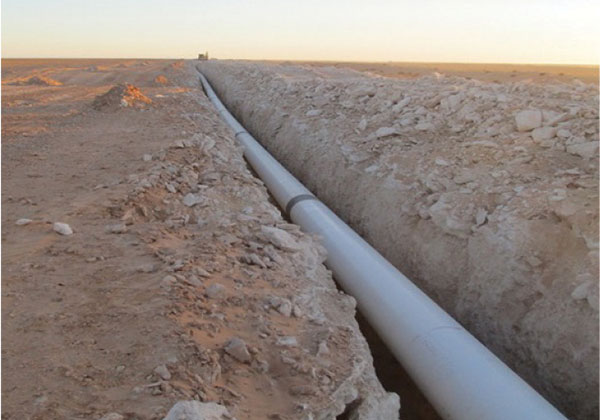December 2018, Vol. 245, No. 12
Features
Tunisia Pushes Forward with New Pipeline
By Shem Oirere
Tunisia is positioning itself to be North Africa’s next gas producing and processing hub as the country anticipates the soon-to-be completion and commissioning of the 230-mile (370-km) Southern Tunisian Gas Pipeline (STGP) project by national oil company Entreprise Tunisienne d’Activités Pétrolières (ETAP).
This drive by Tunisia, which gets nearly 90% of its energy needs from gas-fired power stations and imports about 50% of its natural gas requirements, to increase its ability to produce and treat natural gas, especially from the Nawara fields located 31-mile (50-km) southwest of Hammouda, would enable the country have a reliable source of energy for powering the country’s electricity generating power stations in addition to reducing its energy import bill.
The 28-inch STGP pipeline, with a capacity of nearly 10 MMcm/d, traverses four Tunisian governorships of Tataouine, Mednine, Kebili and Gabes, and has 12 switching stations, meeting the American Society of Mechanical Engineers (ASME) standards.
The African Development Bank (AfDB), provided an initial $75 million for the STGP pipeline project, which is 50:50 joint venture by ETAP and Vienna-based integrated oil and gas company OMV’s subsidiary OMV Tunisia. The company said the undertaking is necessary “for the development of the gas fields of the Tunisian south and reinforcement of exploration of natural gas reserves as well as meet required contribution to the country’s energy balance.”
The steel pipeline also has 12 cutting valves along the pipeline to ensure the control and the safety of the transfer of gases to Nawara gas processing center, according to the AfDB project brief. It is at this center that the natural gas from the producing fields of Nawara-1, Ahlam-1, Ahlam-2, Sourour, Fella, Ritma and Khouloud, Benefsej-1 and Benefsej Sud-1, will be compressed before it transported via the 370-km pipeline.
Moreover, the pipeline, with a production run of 30 years, is associated with a 4- MMcf/d gas treatment plant at Ghannouch in the industrial park adjacent to Gabes including liquefied storage installations.
“The gas will be conditioned for sale (at the treatment plant,) whereas the condensate (LPG) will be recovered to produce commercial propane and butane,” says the project brief by AfDB. The condensate will then be conveyed through a new 10 km pipeline linking the CPF to the existing Compangnie Des Transport Par Pipe-Lines Au Sahara (TRAPSA) pipeline, while the pre-treated gas will be exported via the new pipeline to the LPG treatment and production center located in Gabes industrial zone.
Some of the key contractors involved in the STGP project are Max Streicher-Bouchammoui Industries JV for the Nawara CPF and associated gas flowlines, Swedish-Swiss multinational corporation for the turnkey delivery of the Nawara gas treatment plant, including gas separation and liquefied petroleum gas extraction units, and Italian independent company Enereco SpA for design support to the procurement activities.
Apart from the main pipeline, Streicher-Bouchammoui was also responsible for the 6-inch condensate line, from Nawara CPF to the TRAPSA pipeline tie-in, a distance of 7.5 mile (12-km); the 20-inch sales gas pipeline from Gabes gas treatment plant to Tunisian Company of Electricity and Gas (STEG) at Gabes, covering 0.6 miles (1 km).
In addition, Streicher-Bouchammoui was also to link the state-owned Tunisian firm that operates the country’s Agil service station network, Societe Nationale de Distribution des Petroles (SNDP), in connecting the gas treatment plant with a 6-inch propane pipeline in addition to laying a 0.6-mile (1-km), 4-inch butane pipeline from the gas treatment plant to SNDP facility.
Canadian specialist in oil and gas processing infrastructure designing, fabricating, and installation, Thermo Design Engineering was chosen for the electrification work, while Italian engineering services firm Rina Consulting was picked for the health, safety and environment works and EMG Group was selected for.
As part of the STGP project, ETAP has a flowline system linking the producing gas wells to the 2.7 MMscm/d Nawara central processing facility (CPF).
The oil and gas infrastructure would ensure flow from the country’s production fields to meet the balance of the country’s energy demand including consumption of 4,430 megawatt (MW) of electricity by 2019 and expected to rise to 5,510 MW by 2024. An increased production and supply of natural gas would enable Tunisia to support the projected 24% surges in generation capacity by next year and 57% by 2024.
Currently, Tunisia, which produces an average of 40,000 bpd of oil and 224,583 cf/d of natural gas, has an extensive pipeline network, including 1,900 miles (3,059 km) of gas pipelines, 748 miles (1,203 km) of oil pipeline and 214 miles (345 km) of refined products.
With the STGP gas pipeline project, which commenced in 2015, Tunisia’s national oil company (ETAP) is making progress in the implementation of its 2013-2020 investment plan. Although no firm confirmation has been given on when the STGP pipeline project will be completed and commissioned, ETAP has indicated the overall STGP would be commissioned in May 2019, paving the way for more gas production through drilling of additional wells, maintenance of current production levels and a delay in exhaustion of Tunisia’s 23 concessions in which the national energy company has a participating interest. P&GJ
Author: Shem Oirere is a freelance journalist based in Nairobi, Kenya.






Comments